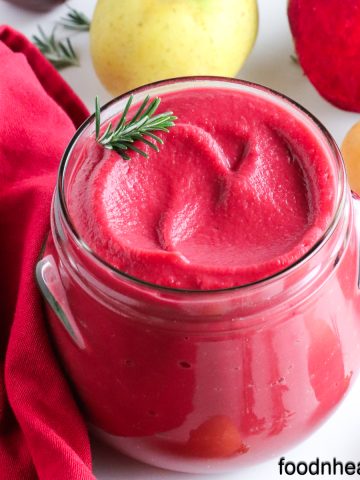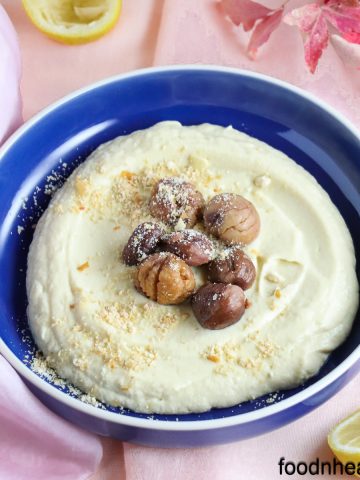Crafted with love and bursting with natural goodness, this homemade applesauce features the perfect ingredients to nourish both body and soul. Infused with the warm embrace of star anise, the comforting flavor of cinnamon, and the subtle note of nutmeg. This applesauce with buttercup squash, apples, and celeriac is a nutritional powerhouse, delivering several health benefits with every spoonful.

Celeriac also referred to as celery root, knob celery, or turnip-rooted celery, belongs to the same family as celery but possesses a distinct appearance. It's a rounded base adorned with multiple knobs and protrusion, crowned with leafy stalks similar to the classic celery.
I created this applesauce, particularly for my daughter, who doesn't like squashes or celeriac. Blending these two ingredients with sweet apples creates a masterpiece she savors without resistance!
Celeriac may not achieve the pedal steel of celery in the culinary world, but its health benefits are worth including in your diet. Here are some of the most potent benefits of celeriac:
- Rich in nutrients: Despite its appearance, celeriac contains essential nutrients like vitamins C and K, phosphorus, potassium, and fiber. These nutrients support overall health, including immune function, bone health, and digestion.
- Low in calories: Celeriac is a fantastic choice for those concerned about weight. It's low in calories but high in fiber, leaving you feeling fuller for hours.
- Supports digestive health: Celeriac is rich in dietary fiber, which adds bulk to stool and promotes regular bowel movements. Consuming adequate fiber can help prevent constipation and support a healthy digestive system.
- May Lower Blood Pressure: Potassium is abundant in celeriac. It's known for its role in regulating blood pressure. By balancing sodium levels in the body, potassium helps relax blood vessels, lowering blood pressure levels and reducing the risk of cardiovascular disease.
- Promotes Bone Health: Celeriac contains vitamin K essential for bone health and blood clotting. Adequate intake of vitamin K has been associated with a reduced risk of fractures and improved bone density, making celeriac a valuable addition to your diet.
- Anti-inflammatory Properties: Celeriac contains apigenin, a polyphenol that can successfully inhibit the onset and severity of arthritis by decreasing the secretion of pro-inflammatory cytokines TNF-α, IL-1β, and IL-6 in the serum.

Buttercup or Kabocha squash benefits
I love buttercup squash for its sweetness, nutty flavor, and vibrant orange flesh. Its dark green skin with dense flesh makes this homemade applesauce creamy and delicious.
Buttercup squash is relatively high in starch and low in sugars at harvest, but the conversion of starch to sugar improves flavor, texture, and sweetness. Buttercup is higher in potassium and antioxidant properties than squashes like butternut.
You definitely can use other squashes, but avoid pumpkins with high water content for a creamier applesauce.
Like most squashes, buttercup or kabocha makes meals delicious and offers a range of health benefits. They are;
- Nutrient-rich: Buttercup squash contains essential nutrients, including vitamins A, C, and E, as well as B vitamins like folate and B6. These vitamins are crucial in immune function, skin, and vision health. Vitamin B6 is essential in the synthesis of iron.
- High in dietary fiber: Squashes like buttercup and kabocha support digestive health by promoting regularity and preventing constipation due to increased dietary fiber content.
- Source of antioxidants: Buttercup squash contains antioxidants such as beta-carotene, lutein, and zeaxanthin, which help protect cells from damage caused by free radicals. Lutein is highly found on the peel than the flesh, so do not peel most squashes.
- Great for your vision: Beta-carotene (a precursor to vitamin A) and lutein are essential for maintaining healthy vision. Buttercup squash is a rich source of beta-carotene and lutein, which can help protect against age-related macular degeneration and promote overall eye health.

What apples are best for applesauce?
When making homemade applesauce, using different varieties of apples can be a game changer. Apples have a diversity of textures and sweetness, and by adding them together, you create a unique blend you can hardly get anywhere else.
To make this recipe with celery root, look for sweet apples; you want to counteract the celeriac flavor, especially when you have people who don't appreciate its flavor!
Apples like fuji, gala, and golden are sweet and perfect for this recipe. I purchase my apples from local farmers; in this case, I do not peel the apples.
Buy organic apples whenever possible; if not, clean apples with warm water, then soak them in water with baking soda for about 15 minutes. Rinse thoroughly. Baking soda has been studied to eliminate up to 90% of pesticides on the peels.
A simple preparation
This homemade applesauce is relatively simple to make.
- I like cooking celeriac and pumpkin in healthy fats like coconut or olive oil for better flavors.
- I use whole spices. In this case, star anise and cinnamon.
- Then I add diced apples and let cook till everything is soft.
- I often leave these to rest for several hours or overnight to let the flavors infuse.
- Using a high-speed blender or a hand (immersion) blender, I blend the mix till I obtain a smooth, velvety texture.
I hope you'll like this homemade applesauce. Each ingredient enhances your overall well-being, from supporting eye health with beta-carotene to promoting digestive wellness with fiber-rich celeriac. Plus, it's sugar-free, so you can indulge guilt-free, knowing you're nourishing your body with pure, wholesome natural ingredients.
Be part of the conversation and share your insights to enrich others with diverse perspectives.
Sending you my love, Githu.
Try these amazing applesauce
Recipe
New homemade applesauce infused with celeriac & pumpkin
Equipment
- kitchen knife
- cooking pot
- a high-speed blender or immersion blender
- Mason jars
Ingredients
- 2 cups celeriac
- 3 cups buttercup/kabocha/red Kuri
- 2 tablespoon coconut oil
- 2 cinnamon stick
- 4 star anise
- ¼ salt
- 10 medium apples (different varieties)
- ¼ nutmeg
Instructions
- Clean the fruits and vegetables.
- Cut the base and the top of the celeriac Peel the rest using a vegetable peeler.
- Dice the celeriac into cubes and put them in a cooking pot.
- Cut the buttercup into halves, remove the seeds of one half, dice it, and put it in the pot. Do not peel.
- Place the cooking pot on a heat source, add coconut oil, cinnamon sticks, anise, and stir.
- Cover the pot to cook on medium-high heat for about 8 minutes.
- Meanwhile, dice the apples without peeling them (read the blog post), and keep the cores to make a vegetable broth.
- Add salt to the cooking ingredients, stir well, then add the diced apples.
- Stir well, cover, and leave the apples to cook till tender.
- I normally lower the heat to low, and let the apples cook for about 20 minutes.
- Cut the heat and leave to cool. I leave mine for 6 hours or overnight.
- Remove the cinnamon and anise stars before blending.
- Sprinkle with freshly grated nutmeg for more flavor.
- Serve as desired and transfer the rest to mason jars.
Notes
- I normally make a huge amount of this applesauce and serve it as a dessert or snack.
- It keeps well in the fridge for up to a week.
- You can reduce the amount of celeriac or pumpkin; either way, it doesn't alter the recipe.
- For more sweetness, use more apples and less celeriac.






CG
I love this homemade applesauce; it makes my girl eat celeriac and pumpkins, 2 veggies that she doesn't like.
Jess
I love all the benefits in this one recipe!
Githu
Thank you Jess. Do you eat celeriac?